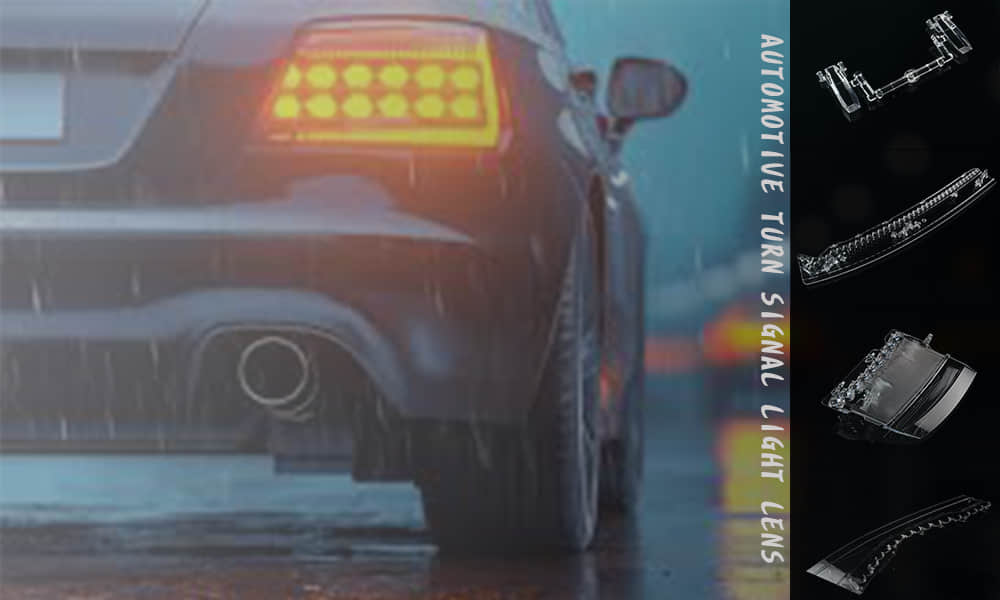Turn signals are the universal language between vehicles and their surroundings. They communicate a driver’s intentions clearly and quickly, reducing the risk of misunderstanding and preventing accidents. For a warning signal to be truly effective, it must meet three critical requirements: high recognizability, fast response, and reliability under all weather conditions.
In the era where LED technology dominates automotive lighting, these qualities are no longer defined by LED chips alone. The optical lenses in front of them are the real engineering drivers. Lens design determines how light is distributed, its intensity, and its clarity, ensuring that turn signals comply with strict international regulations such as ECE R6 and SAE J588, while maximizing road safety.
Shaping Clear Light Patterns with Superior Uniformity
Under bright daylight, turn signals must deliver extremely high central luminous intensity and a distinct, highly visible beam pattern. Poor optical designs can lead to uneven light distribution, producing distracting artifacts like “petal patterns” or granular light spots. Such imperfections reduce signal recognition speed and compromise safety.
Using freeform surfaces and micro-texture structures, Asahi optical engineers precisely sculpt light patterns that meet ECE and SAE requirements. We ensure that high-intensity “hot zones” fall within required angles so the signal is visible from every regulatory perspective.
Through secondary optical design and optimized diffusion techniques, we eliminate spotty LED artifacts, creating a smooth, full, and consistent luminous surface. The result is a crisp, uniform visual signal that drivers and pedestrians can immediately recognize.
Controlling Light Response and Dynamic Effects
Turn signals are expected to reach peak brightness instantly. With the growing popularity of dynamic sequential indicators, smooth transitions between LED segments are essential to avoid confusing other drivers. Here, lens design plays a critical role in how the human eye perceives motion and brightness.
- Rapid Light Extraction: We design precision light guide lenses with optimized micro-optical structures to maximize light transmission efficiency and minimize loss. Each LED lights up quickly and evenly, ensuring instant signal recognition.
- Dynamic Flow Optimization: By carefully arranging optical units, our designs produce seamless sequential effects where brightness transitions smoothly between segments. This delivers a visually intuitive flow that makes vehicle movement intentions unmistakably clear.
Ensuring Long-Term Reliability in Harsh Environments
Automotive turn signals are exposed to constant environmental stress — from extreme heat to UV radiation, vibrations, and chemical exposure during washing. Over time, inferior materials can yellow, fog, or degrade, reducing luminous output and creating safety risks.
Asahi uses automotive-grade, durable, high-performance materials, including PMMA and PC, with excellent UV resistance and a very low yellowing index (ΔYI), ensuring long-term optical clarity throughout the vehicle's lifespan. They can also withstand sustained high temperatures (>110°C) and are resistant to chemicals like cleaning agents, ensuring stable performance even under the most demanding conditions.
Automotive turn signals are no longer simple lights — they are an integral part of active vehicle safety systems. A precisely designed optical lens ensures that every signal is instantly recognizable, highly visible, and fully reliable, regardless of driving conditions.
At Asahi Optics, we go beyond delivering components. We provide comprehensive optical solutions that integrate regulatory expertise, material science, and precision engineering. By partnering with automakers and Tier-1 suppliers, we help create safer, more intuitive automotive lighting systems that enhance both safety and design aesthetics.
Discover more about our automotive lighting solutions:
Automotive Lighting Optics | Automotive Turn Signal Light Lens

